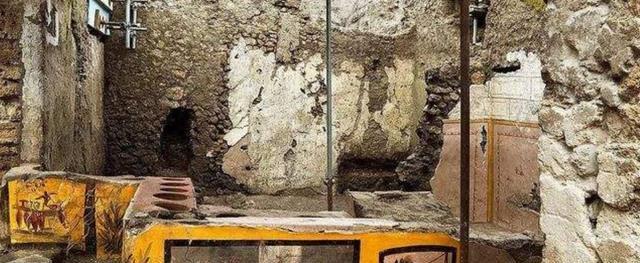In today's society, with the development of business, people are paying more and more attention to brands and trademarks, and there are more and more lawsuits caused by this, indicating that people's awareness is also constantly strengthening. But what you may not know is that in ancient Rome more than 2,000 years ago, merchants have begun to use trademarks, such as the bread found in Pompeii, there are names left by the makers... What the hell is going on here? The following Xiaobian will reveal the secret to you from scratch.
(All pictures in this article, all from the network, thanks to the original author, if you infringe your rights, please contact the author of this number to delete.) The picture has nothing to do with the content, please do not enter the seat)
Pompeii was a famous city in ancient Rome and the second largest city in ancient Rome, located in the southwest of the Apennine Peninsula, which is now Naples, Italy. Archaeological studies have shown that Pompeii was built in the 6th century BC, but was tragically destroyed in a disaster more than 80 years later. In 79 AD, Mount Vesuvius, less than 10 kilometers from Pompeii, suddenly erupted, which surprised everyone, and for a time the volcanic ash covered the sky, spewing hot magma like a flood to Pompeii. Many people were too late to escape, and even in their sleep they were inundated with volcanic ash and lava, Pompeii was destroyed overnight, and all the houses, roads and residents, all of which became history under the 5.6-meter volcanic ash.

In this way, Pompeii disappeared, as if erased from the earth by nature, and left no trace. It was not until the 18th century that Pompeii, which had been buried for more than 1,800 years, was discovered, and the large number of remains testified to the terrible catastrophe. Since the discovery of Pompeii, the Western archaeological community has boiled over, and over the past 200 years, experts have carried out many excavations of the Pompeii site, and have also unearthed a large number of workshop sites and rare artifacts, as well as countless human and animal skeletons. In addition, experts also found food in the ruins of a house, because the volcanic magma came too suddenly, so many of the food was immediately carbonized when it encountered the magma, and thus it has been preserved to this day.
After research, experts determined that these foods had beans, carrots, onions and walnuts, etc., which also let us know the diet of the Pompeii people at that time, which was also of great value for later research. In recent years, archaeologists have discovered many workshop sites, and in one of the workshops unearthed a lot of dark large discs, at first they thought it was charcoal, but later after ingredient testing, it was determined that it was carbonized bread, which showed that this workshop was a place to make bread.
Carbonized bread is round, about 16.5 cm in diameter, and there are traces of style on the surface, if it is not carbonized, it must look very delicate. In later studies, experts also found that some of the bread also had inscriptions, which were later deciphered by paleographers and determined that the inscription was a name, that is, the slave of Sile Quintas Granes Verus. Experts believe that Siler Quintas Granes Verus was the owner of the bakery, and he hired several slaves to make bread for himself. In this way, the bread of Verus is different, because there is an inscription that has a brand attribute, and people will look for the "Verus brand" when they buy bread, so experts speculate that there were many people making bread at that time, and Verus was one of them.
While people are still studying the "Verus Brand" trademark, some experts have come up with new ideas, that is, to restore Pompeii bread and taste how it tastes. In 2013, Giorgio Locatelli, a Michelin chef in Italy, tried it out, consulting a large number of ancient Roman sources and finding some of the ingredients that might have been used to make bread at that time, the most important of which were flour, yeast, and some accessories. After several attempts, chef George Otley managed to make a piece of bread that was the same as carbonized bread, but he said it felt a little sour.
Experts say that the bread made by George Otley can only be said to look very similar, but the taste is not necessarily the same, after all, the recipe of more than 2,000 years ago can not be found, and it is good to figure out 30% of the recipe. However, George Otley also solved a problem for experts, because the excavated carbonized bread has grooves on the outer edge, so the experts do not know what the grooves are for. George Otley said in the process of making bread that when baking bread, a circle of rope should be used on the outer edge of the bread, which can make the baked bread the same size, and then, when selling, directly carry the rope, do not pollute the hand, and it is also convenient to carry, the merchant also saves the packaging, it can be said that killing two birds with one stone.
Other than that. The bread was tied with a rope, which could hang the bread, because there were many rats in Pompeii at that time, and hanging the bread could avoid the theft and destruction of the rats.
Finally, the inhabitants of Pompeii, with bread as the staple food, every family must prepare some bread for emergency needs, and the bread hanging up can not only prevent mildew, but also show that the host family has a lot of grain, rich and well-off.
Resources:
"Three Days in Pompeii" by Alberto Angela Publishing House: China Social Sciences Press
Wenlan Hairun Studio Editor-in-Chief Wen Xiucai, this article is written by: Special History Writer: Liu Lijiang's